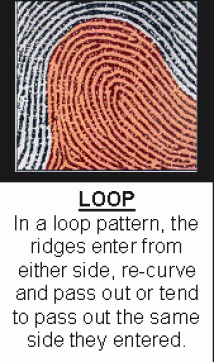Science Observations and Techniques with Enlarging Lenses, Science Notebook Details

Fingerprint Loop Pattern
Science Lab Notebooks for Students' Magnifier and Other Observations are Important
All observations should be recorded in a bound notebook that has the scientist's name on the outside, e.g. "Scientist, Wendy Williams" or "Scientist, Johnny Jones". Remember to record the data with a non-erasable pen ink. Make sure each page is numbered consequetively in the upper right, or upper left corner of each page – 1,2,3..., and that a full date is supplied for each page, 3/1/2010. Every notebook should have the following: Name of the Experiment, Materials and Methods, Experiments Done, Results, and Conclusions as part of the basic experiment. Good, scientific note-taking marks the beginning of good science. Make sure each observation is recorded clearly and completely.
1. Magnifier and Fingerprints Science Experiment and Observations
Face the palm of one hand upward, and with the aid of the magnifier check the finger pads for fingerprint patterns. Look in the middle of the fingerprint region for the distinctive ridges that form loops, whorls, or arches. Compare the arch, loop and whorl pattern, and describe what is seen in the notebook. If unsure of loops, arches and ridges, refer back to the FBI figures and determine the pattern as closely as possible. Compare fingerprints between 2 people, or among 3 or more.
2. Magnifier Fingernail Science Experiments
Look at the end of each of each finger, where the nail overlaps the finger; see if there is dirt, or debris under or around any nail. Do all ten fingers and determine how many had noticeable dirt or debris under the nail (be honest).
Record your findings in the notebook. Also, examine the top surface of each nail and its perimeter. Anything interesting observations to report?
3. Magnified Print and Letters on Papers Experimental Science Observations
Obtain a few pieces of paper (magazines, news papers books, handwriting) with letters of various sizes and scan the letters for the ink and paper fiber color and weave. Do the letters looks clearer and cleaner under the magnifier? Are the paper threads more distinct where there is ink? What direction(s) or pattern do the fibers appear to be arranged in? Record these observations in the notebook.
4. Torn Paper Edges and Magnifier Scientific Analyses
Get a small piece of clean, unused, toilet paper, paper toweling, newspaper and tear each at an edge for observation purposes. Use the magnifier to observe the edges of each paper. Make a sketch of what is seen in each case, and write these into the lab notebook. What major biochemical compound is paper? Remember that paper is made from trees and plants. Record the observations made.
5. Magnified Sugar and Salt Crystal Experimental Science Observations
Find some sugar and salt crystals, and place them in identifiable locations on a dark surface for a clearer, contrasting view. Carefullyobserve the sugar and salt crystals. Are they the same size? Are they the same shape? Are they the same color? What shape is typical for each crystal? Salt has the chemical formula, NaCl (sodium chloride); sugar has the formula C12H22O11 (sucrose). Make a sketch of each crystal, and include a written description in the notebook.
This is the start of a notebook exercise that may be expanded and added to with many different kinds of experiments. Over time, and hopefully quickly, each student will become a more skilled investigator and scientist.
All the Written Material within Site is Copyrighted 2010 and Owned by Dr. Donald Reinhardt, and this original material is protected legally by this copyright notice and by the Digital Millennium Act. None of this original material may be copied or reproduced without the expressed written consent of the author.
The author is a Freelance Science writer, and is available for specific assignments for those who are interested – by contacting adminstrator@sciencesuperchool.com. Other questions related to this teaching site should be directed to teacher@sciencesuperschool.com.